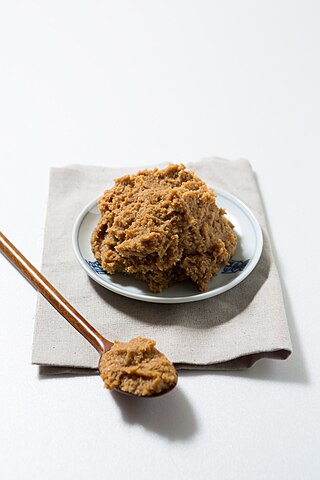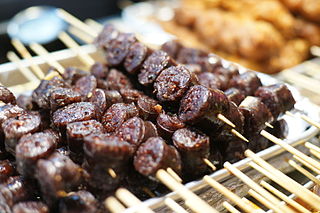Related Research Articles

Korean cuisine has evolved through centuries of social and political change. Originating from ancient agricultural and nomadic traditions in Korea and southern Manchuria,Korean cuisine reflects a complex interaction of the natural environment and different cultural trends.

Bulgogi is a gui made of thin,marinated slices of meat,most commonly beef,grilled on a barbecue or on a stove-top griddle. It is also often stir-fried in a pan in home cooking. Sirloin and rib eye are frequently used cuts of beef for the dish. Bulgogi is a very popular dish in South Korea,where it can be found anywhere from upscale restaurants to local supermarkets as pan-ready kits.

Fried rice is a dish of cooked rice that has been stir-fried in a wok or a frying pan and is usually mixed with other ingredients such as eggs,vegetables,seafood,or meat. It is often eaten by itself or as an accompaniment to another dish. Fried rice is a popular component of East Asian,Southeast Asian and certain South Asian cuisines,as well as a staple national dish of Indonesia. As a homemade dish,fried rice is typically made with ingredients left over from other dishes,leading to countless variations. Fried rice first developed during the Sui dynasty in China.

Bibimbap,sometimes romanized as bi bim bap or bi bim bop,is a Korean rice dish.

Gochujang or red chili paste is a savory,sweet,and spicy fermented condiment popular in Korean cooking. It is made from gochu-garu,glutinous rice,meju powder,yeotgireum,and salt. The sweetness comes from the starch of cooked glutinous rice,cultured with saccharifying enzymes during the fermentation process. Traditionally,it would be naturally fermented over years in jangdok (earthenware) on an elevated stone platform called jangdokdae in the backyard.

Tianmian sauce,also known as sweet bean sauce,sweet flour sauce or sweet wheat paste,is a thick,smooth,dark brown or black paste with either a mild,savory or sweet flavor. It is commonly used in Northern Chinese cuisine,Northeastern Chinese cuisine,as well as Korean-Chinese cuisine. Peking duck and jajangmyeon are two popular dishes that feature the sauce.

Samgyeopsal,samgyeopsal-gui,or grilled pork belly is a type of gui in Korean cuisine.

Korean royal court cuisine was the style of cookery within Korean cuisine traditionally consumed at the court of the Joseon Dynasty,which ruled Korea from 1392 to 1910. There has been a revival of this cookery style in the 21st century. It is said that twelve dishes should be served along with rice and soup,with most dishes served in bangjja (bronzeware).

Doenjang or soybean paste is a type of fermented bean paste made entirely of soybean and brine used in Korean cuisine. It is also a byproduct of soup and soy sauce production. It is sometimes used as a relish.

A rice cake may be any kind of food item made from rice that has been shaped,condensed,or otherwise combined into a single object. A wide variety of rice cakes exist in many different cultures in which rice is eaten. Common variations include cakes made with rice flour,those made from ground rice,and those made from whole grains of rice compressed together or combined with some other binding substance.

Banchan are small side dishes served along with cooked rice in Korean cuisine. Banchan are often set in the middle of the table to be shared. At the center of the table is the secondary main course,such as galbi or bulgogi,and a shared pot of jjigae. Bowls of cooked rice and guk (soup) are set individually. Banchan are served in small portions,meant to be finished at each meal and replenished during the meal if not enough. Usually,the more formal the meals are,the more banchan there will be. Jeolla province is particularly famous for serving many different varieties of banchan in a single meal.

Sundae is a type of blood sausage in Korean cuisine. It is a popular street food in both North and South Korea,generally made by steaming cow or pig's intestines stuffed with various ingredients.

Korean barbecue is a popular method in Korean cuisine of grilling meat,typically beef,pork or chicken. Such dishes are often prepared on gas or charcoal grills built into the dining table itself. Some Korean restaurants that do not have built-in grills provide customers with portable stoves for diners to use at their tables. Alternatively,a chef uses a centrally displayed grill to prepare dishes that are made to order.

Po is thin strips or sheets of dried meat and fish used in Korean cuisine. Po,which is made from meats including beef,pork,venison and poultry;and seafoods including whitefish,eel,squid,octopus,shrimp and crab;is eaten as snack food,banchan or anju. Po is prepared for traditional occasions such as pyebaek and jesa.

Bap is a Korean name for cooked rice prepared by boiling rice or other grains,such as black rice,barley,sorghum,various millets,and beans,until the water has cooked away. Special ingredients such as vegetables,seafood,and meat can also be added to create different kinds of bap. In the past,except for the socially wealthy class,people used to eat mixed grain rice together with beans and barley rather than only rice.

North Korean cuisine is the traditional culinary practices and dishes of North Korea. Its foundations are laid by the agricultural and nomadic traditions in southern Manchuria and the Korean Peninsula. Some dishes are shared by the two Koreas;however,availability and quality of Northern cuisine is much more significantly affected by sociopolitical class divides.
References
- ↑ Kim, Yoo-sung (9 June 2015). "Ask a North Korean: what's the street food speciality?". The Guardian .
- 1 2 Kim, Soo-yeon (30 May 2016). "S. Koreans hope food will bring divided Koreas closer together". Yonhap News.